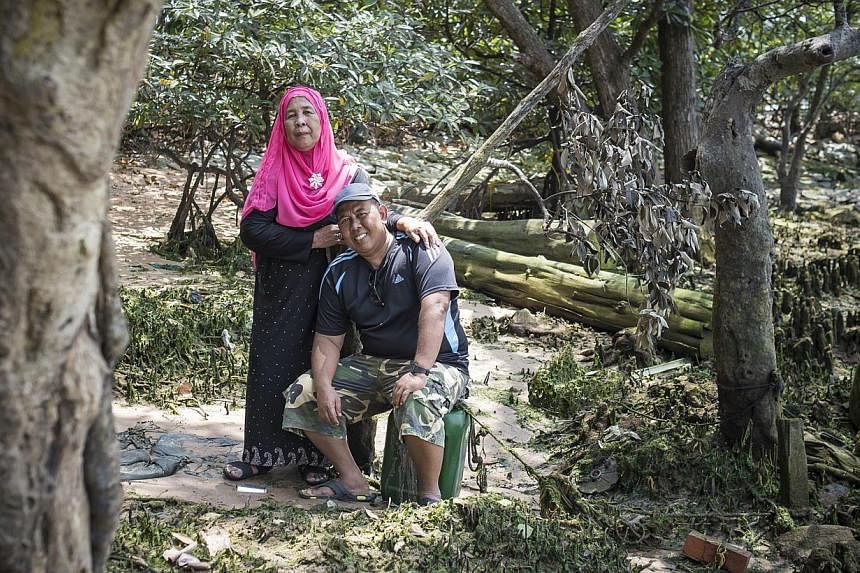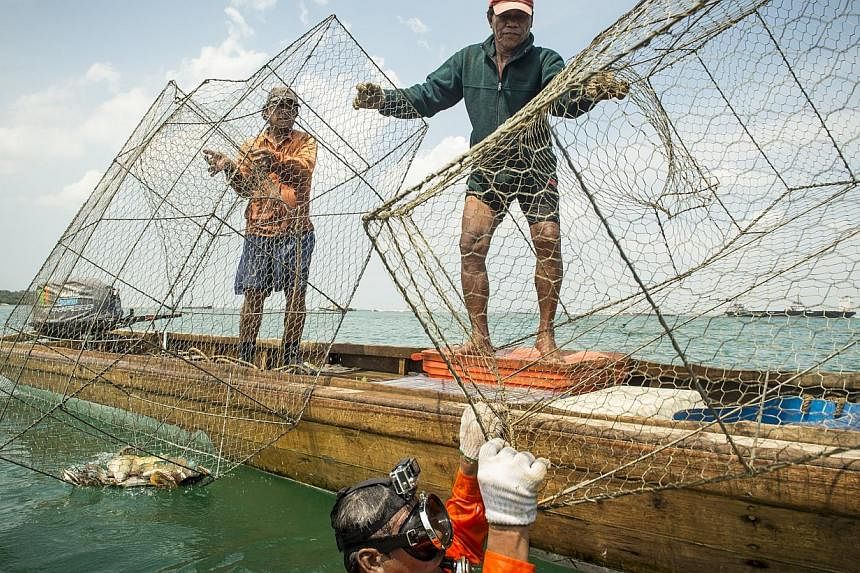Some habits die hard, especially for a group of former residents of Pulau Sudong, an island south of the Singapore mainland.
Every Saturday and Sunday morning, about 20 of them set out from West Coast Park on their motor boats packed with traditional fish traps called bubu. These are conical iron-mesh traps placed on the seabed during low tide.
One of these dedicated fishermen is delivery driver and father of four Hamzah Mohamad, 60, who says he seldom buys fish from the market.
He says: "Having grown up by the sea, you get used to eating fish fresh from the sea. They have a kind of sweetness to them."
He now lives in a three-room HDB flat in West Coast with his wife and youngest daughter.
These weekend fishing trips hark back to a simpler, more rustic "island lifestyle": the fishing culture common to Pulau Sudong and the southern islands of Singapore.
The way of life on some of these islands was considerably more communal compared with mainland Singapore.
Each island was a self-contained community consisting of mostly Malay families. Some families subsisted on fish caught by the men while a few grew their own vegetables or kept chickens. Some had cats or goats.
Overseen by a village chief (called the penghulu), some of these islands had amenities such as a community centre, a police post, a school, a mosque, a cemetery and a couple of provision shops. There was also a dispensary where a nurse would drop by a couple of times a week to do post-natal checks and give injections.
Not all the islands had villages; some had specific uses. For instance, Pulau Senang was once a penal colony and Pulau Satumu had a lighthouse, and its residents were the wardens and their assistants.
In any case, most islanders resettled on the mainland between the 1970s and 1990s for various reasons. For instance, Pulau Sudong was turned into a military live firing area while Pulau Seking and Pulau Semakau were joined to enclose a rubbish landfill.
However, there remains considerable interest in life on these islands even though it has disappeared due to resettlement and development.
Island life has inspired recent projects such as Balik Pulau: Stories From Singapore's Islands, an exhibition held last August at the National Museum of Singapore.
Most recently, these southern islanders are the subject of a documentary project called Island Nation, by photographers Edwin Koo, 36, Zakaria Zainal, 30, and Juliana Tan, 25. Their aim was to capture a part of history which they say is not recorded in textbooks.
Their project is part of the National Library Board's Singapore Memory Project, which showcases Singapore memories leading up to this year, when Singapore turns 50.
Island Nation is by far the most ambitious project undertaken to record the oral history of life on 12 of the southern islands. The islands are: Sentosa, Pulau Seringat, Pulau Brani, Lazarus Island, Kusu Island and St John's Island on the eastern part, and Pulau Bukom, Pulau Semakau, Pulau Seking, Pulau Sudong, Pulau Senang and Pulau Satumu on the western side.
The photographers have contacted more than 100 islanders aged from their 50s to 90s to collect their stories.
The project will showcase the memories of 30 residents going as far back as the 1940s, using different formats from photo essays and short video clips to text essays and multimedia packages.
These will be put up on a website that will go live next month.
In June, a photo exhibition will be staged at the Lee Kong Chian Reference Library at the National Library of Singapore.
It will feature photographs of the islanders as well as old images from private collections, including those belonging to the handful of islanders who owned cameras.
To be put on display, too, are photographs by the late Britain-born Ivan Polunin, who was well known for making films for the British Broadcasting Corporation on how people lived in Singapore between 1950 and 1973.
Speaking to SundayLife!, these islanders paint a picture of frugal but tightly-knit communities which lacked modern conveniences but made up for it with generosity and friendliness.
Mr Teo Yan Eng, 90, used to help two of his younger brothers who ran a provision shop on Pulau Seking. He says there were 58 families on the island and the 400 to 500 people there "all knew one another".
The Teos were the only Chinese family there, but felt totally at home. He says: "Neighbours dropped by to chit-chat even if they had nothing to buy."
He and his brothers did not fish, but their fishermen neighbours often shared their catch.
During Malay weddings and Hari Raya, the brothers exchanged gifts - usually something from their provision shop or a hongbao - with their neighbours, who gave them kueh and nasi briyani.
Although the islanders mostly interacted among themselves, with some inter-marrying, they also caught up with those from other southern islands, where they had relatives.
There was an annual sports meet called the Pesta Five S, drawing participants from the five islands of Sudong, Semakau, Sakijang Bendera (now known as St John's Island), Seking and Seraya. Pesta is the Malay word for carnival.
The islands took turns to host the games, which took place over a few weekends. There were land games such as tug-of-war and soccer, as well as water games such as sampan races.
Mr Rosli Manan, 51, a constituency support executive who was born in Pulau Sudong, recalls turning up with other village children for these meets. "It was a very lively time for the islanders," he says.
Life was austere then, as most of the islands lacked running water and sometimes, electricity.
Mr Teo of Pulau Seking remembers using kerosene lamps at night. To get fresh water for cooking and drinking, his brother took 15-minute motor boat rides to Pulau Bukom, returning with big covered pails of water.
Pulau Bukom was one of the more developed islands in the south because Singapore's first offshore oil refinery opened there in 1961. It also had a hospital where Mr Teo's brother was sent to when he got a sharkfish bone stuck in his foot while walking on the beach.
Living so near the coast also made them more vulnerable to the elements. A big storm once blew off the roofs of a few attap houses, including that of the Teos'.
Despite these challenges, Mr Teo has fond memories of his island life. He says: "The air was fresher and we had fresh fish to eat every few days."
In fact, a common refrain among older islanders, who have been relocated to the mainland, seems to be an intense longing for the past.
The young looked forward to the move. Mr Rosli of Pulau Sudong says that when he had to move at the age of 15, he was very excited. He had already been spending his weekdays on the mainland at his aunt's place as he was studying at Yusof Ishak Secondary School.
"We were looking forward to having a new flat with better amenities."
His family of eight were given about $3,000 by the Government and bought a three-room HDB flat in Clementi.
So they wrapped up their clothes and cooking utensils with bedsheets and packed them into boxes bought from the mainland. They had to be careful because there was not going to be a return trip.
Like most of the villagers, they donated their furniture and boats to their relatives in Indonesia. Livestock such as chicken were also given away.
Mr Hamzah adapted quickly to life in Singapore, but his late father-in-law, Mr Yakop Getim, who was born on the island and resettled on the mainland in the 1970s, could not get used to living in an HDB flat.
He built a home for himself out of a sampan moored at West Coast Park and continued to live there till he died a few years ago. He slept on a straw mat in the sampan and used a kerosene lamp to help him see at night. He made a living looking after boats and engines for their owners.
But for Mr Hamzah and other former Pulau Sudong residents, the island lifestyle is a thing of the past. Going out to sea every weekend to fish, and catching a glimpse of their beloved island, will have to do.







